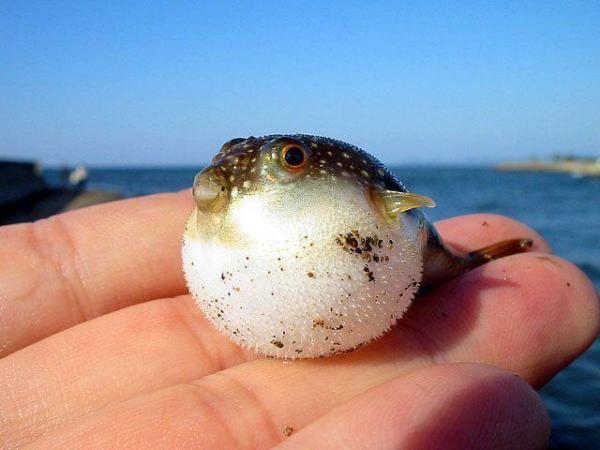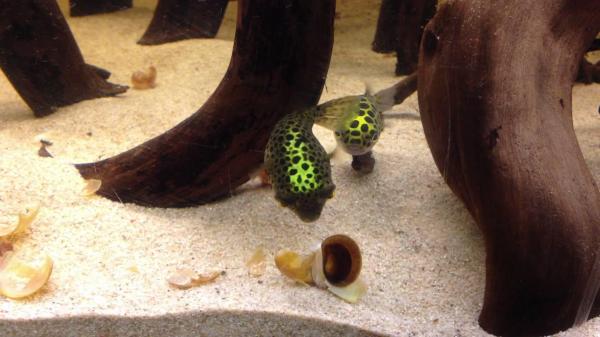Green Spotted Puffer Diet


The freshwater green spotted puffer (Dichotomyctere nigroviridis) is undoubtedly one of the most valuable specimens for fish keepers due to its beautiful colors and strange shapes. This appearance may vary from fish to fish. In order for your pet pufferfish to live for a longer time, you should read about its dietary requirements. For this reason, this AnimalWised article will go over the green spotted puffer diet. We look at what food to feed a green spotted puffer fish, as well as how is best to feed them in terms of routine and quantity.
What are green spotter puffers like?
If you're looking for information on the green spotted puffer because you like the idea of having one in your fish tank, you should learn about their traits and requirements before making any decisions. Despite being perceived as small, the green spotted puffer can grow to be between 13-18 cm (5-7") in length. It's a beautiful fish that is capable of inflating when it feels threatened, scared or excited. This is where they get their common name.
This species capable of secreting a substance called tetrodotoxin when they feel threatened, which can kill other creatures inside the aquarium. Green puffer fish are aggressive, dominant and often reluctant to share their space with others. They love to snoop around everything in their immediate vicinity.
- Attention: In the picture, the fish has been taken out of the water for a few seconds in order to take a high quality photograph. It is very important for your pufferfish' health that you never do so at home.

What do green spotted puffers eat in their natural habitat?
In the wild, green spotted puffer fish are types of carnivorou animals and have a diet that primarily consists of various small aquatic invertebrates and occasional plant matter. Their natural diet can vary depending on their habitat, but it typically includes the following:
- Snails: green spotted puffer fish are known for their fondness for snails. They use their strong beaks to crack open the shells of snails and consume the soft parts inside. This behavior helps maintain their dental health.
- Crustaceans: small crustaceans, such as shrimp and krill, are essential components of their diet. Puffer fish capture and consume these prey items, as they provide protein and nutrients.
- Insects: aquatic insects and insect larvae are another food source for green spotted puffer fish. They hunt and feed on these small invertebrates.
- Worms: puffer fish may also eat small aquatic worms and worm larvae found in their natural habitat.
- Occasional plant matter: while their diet is primarily carnivorous, green spotted puffer fish may nibble on aquatic plants occasionally. Plant matter is not a primary food source but may supplement their diet.
- Algae and plant debris: in some cases, puffer fish may ingest algae or small bits of plant debris while hunting for prey, but these are not their main food sources.
Green spotted puffer fish are opportunistic predators. Their diet can vary based on the availability of prey in their environment. They have specialized beaks and powerful jaws designed for crushing and consuming hard-shelled prey like snails and crustaceans.
When keeping green spotted puffer fish in captivity, it's important to replicate their natural diet as closely as possible by offering a variety of live or frozen animal-based foods to meet their nutritional needs. Providing hard-shelled prey items like snails can also help with their dental health. We look into this in more detail below.
Image from lode.biz

Green puffer fish diet at home
Feeding a domestic green spotted puffer fish in captivity differs from their natural diet in several ways:
- Commercial foods: in captivity, it's common to feed domestic green spotted puffers a diet that includes commercially prepared foods. These can include high-quality puffer fish pellets, sticks, or flakes specially formulated to meet their nutritional needs. These commercial foods are designed to provide a balanced diet and are convenient for aquarium owners. However, some green puffers may not well tolerate commercial fish feed.
- Frozen foods: alongside commercial foods, frozen animal-based foods are often a significant part of their diet. These include frozen brine shrimp, bloodworms, daphnia and other frozen or freeze-dried aquatic invertebrates. These foods are readily available in most pet stores and provide essential nutrients.
- Occasional live foods: while it's not always necessary, some aquarium owners choose to offer live foods as treats for their green spotted puffers. Live foods like small snails, shrimp or worms can replicate their natural hunting behaviors and provide enrichment.
- Plant matter: while green spotted puffers are primarily carnivorous, they may occasionally nibble on aquatic plants in captivity. However, plant matter should be a minor part of their diet compared to animal-based foods.

How to feed a green spotted puffer fish
In addition to the type of food green spotted puffer fish eat, it is important to know how to feed them. This means giving them the right food in the right portions, as well as other factors which are specific to green puffer care:
- Beak maintenance: in captivity, providing hard-shelled prey like snails is essential to help with beak maintenance. Without access to these prey items, their beaks can overgrow, leading to dental issues.
- Portion control: it's crucial to practice portion control when feeding domestic green spotted puffers. Overfeeding can lead to obesity and health problems. Feed them small, frequent meals throughout the day rather than one large meal.
- Variety: offering a variety of foods helps ensure that your puffer fish receives a well-rounded diet and receives all the necessary nutrients. Rotate between different types of commercial foods and frozen or live foods to keep their diet interesting.
- Consult a Veterinarian: if you're uncertain about what to feed your green spotted puffer or need guidance on their dietary needs, consult with a veterinarian experienced in exotic fish care.
Remember that the nutritional requirements of domestic green spotted puffers may differ from those in the wild due to the controlled environment of an aquarium. Providing a balanced diet and replicating their natural hunting behaviors as closely as possible are essential for their health and wellbeing in captivity.

If you want to read similar articles to Green Spotted Puffer Diet, we recommend you visit our Healthy diets category.








